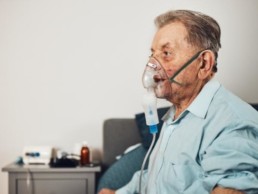Recognizing Our Veterans This Mesothelioma Awareness Day
This September 26th marked the 17-year anniversary of Mesothelioma Awareness Day. This is a day devoted to spreading awareness about this rare and extremely aggressive form of cancer. What many do not know is that mesothelioma is one of the few non-genetic forms of cancer and is usually spoken in tandem with asbestos. Asbestos is the only known culprit of mesothelioma and was heavily used throughout the military from the early 1900s up until the 1980s. Unfortunately, its past use in the military has led to emerging mesothelioma cases today, with roughly 900 new mesothelioma diagnoses annually among our veteran population.
Exposure In The Air Force
For veterans of the Air Force, exposure to asbestos most likely happened on actual Air Force bases. Insulation, wall board, piping, plumbing, sealers, and adhesives were known to contain this carcinogen. Servicemen and women most at risk of exposure were the ones who lived on these bases with their families.
Planes used by the Air Force also contained asbestos in some parts, such as the heat shield, engine, and brake pads. Aircraft mechanics were put at risk as these parts began to wear down and fibers were released into the air. Secondhand exposure was also a risk, as asbestos fibers cling to the clothes. This means that mechanics could have been carrying asbestos off the job site, unknowingly exposing their families when they came home from work for the day.
Exposure In The Coast Guard
Those who served in the Coast Guard were mostly likely to come into contact with asbestos while on shipyards and on ships. Coast Guard Cutters were likely to be harboring asbestos in many different areas of the ship. Pump rooms, boiler rooms, sleeping quarters, and mess halls all could have had asbestos-containing materials (ACMs) present. The close quarters type of living on these vessels allowed for asbestos fibers to travel easily to other areas of the ship, potentially exposing everyone on board. The height of exposure for Coast Guard personnel was during World War II, where usage and production of asbestos was at its peak.
Exposure In The Army
Similar to the Air Force, Army personnel had a high risk of exposure when on Army bases. Insulation, floor tiles, roofing, and cement incorporated this carcinogenic mineral not only because of its fire-resistant qualities, but because it was so cheap. Off-site locations known as Army reserves were also prone to the usage of asbestos. In 2005, the Environmental Protection Agency (EPA) reported that there were still ACMs that needed to be abated from these locations.
Army vehicles also utilized asbestos in some parts that would experience high temperatures and friction. This posed a risk to Army mechanics whose job required them to repair brake pads, gaskets, and clutch plates on vehicles used in combat and transport.
Exposure In The Navy
Navy veterans are the most likely of all military personnel to develop an asbestos-related disease. This is due to the fact that asbestos was most heavily used among this branch of the military. Cruisers, destroyers, aircraft carriers, submarines, and more were often built with ACMs. Asbestos was primarily used in the insulation of these vessels and was also favored because it does not deteriorate easily when in contact with water. The servicemen and women involved in the building, repairing, and retiring of these ships were the ones who most likely were exposed, as the ACMs would degrade overtime.
Exposure In The Marines
Much like the Navy and Coast Guard, veterans of the Marines were also put at risk by being on and working with ships. Marines are often aboard Navy ships being transported to and from conflict areas. While being transported, they carry out maintenance tasks the same as any Navy member would. These duties may involve repairing gaskets or removing insulation, which can disturb and release asbestos. Unfortunately, many of the high-risk ships used throughout World War II and the Vietnam War are still a part of the Navy’s fleet today.
Spreading Awareness
With mesothelioma continuing to affect so many veterans every year, the Purple Heart Foundation believes it is imperative to increase awareness of this disease. This cancer could be diagnosed less, or even disappear, if we are vigilant in protecting ourselves and our military population from asbestos exposure.
Mesothelioma Awareness Day: How This Disease Continues to Impact Veterans
Every 26th of September, Mesothelioma Awareness Day (MAD) is recognized as a day to spread information about this rare disease and educate people about the dangers of its only known cause, asbestos exposure. Of the nearly 3,000 Americans diagnosed with mesothelioma each year, 30 percent of this total are veterans. It is important that we acknowledge the veteran population affected by this disease and continue efforts towards finding a cure.
What is Mesothelioma?
Mesothelioma is a form of cancer that primarily affects the lining of the lungs, but can also be present in the lining of the abdomen and heart. Due to its prolonged latency period, symptoms of this disease typically do not arise for nearly 10 to 50 years. When symptoms do begin to appear, oftentimes, the disease has already progressed to an advanced stage, making treatment options extremely limited.
Historically, the cause of mesothelioma cancer has been linked to asbestos exposure. Asbestos is a naturally occurring mineral that was often used in materials prone to heat and friction. When asbestos is disturbed, airborne fibers have the ability to be inhaled or ingested, gaining access to our internal organs. These fibers lay dormant within our bodies where they cause inflammation and scarring, leading to the development of tumors.
For those diagnosed with mesothelioma, the prognosis is most often very poor. Patients who are diagnosed at an earlier stage are given between 16 to 21 months to live post-diagnosis, which is a limited amount of time to pursue treatment.
How Are Veterans Affected?
Service men and women of our military are susceptible to asbestos exposure as a result of mass historic use of asbestos-products. While there has been a decline in asbestos usage and stricter regulations, asbestos may still be present on military bases, naval ships, and aircraft equipment. Because of this, there is a steady diagnosis rate amongst veterans. This will remain unchanged until asbestos is completely banned in the United States or the government issues a mandate for all asbestos to be removed from military locations.
Those who have served our country between 1920 to 1980 are at the highest risk of developing an asbestos-related disease, as this was the height of asbestos usage. Locations such as the sleeping barracks of ships used in the Navy were tight and limited, allowing for a high concentration of fibers to be present if asbestos was disturbed. Other branches that are affected by asbestos include the Air Force, Army, Coast Guard and Marines through asbestos materials used in things such as aircraft braking systems, military vehicles, and fireproofing for ships.
An additional risk factor that should be kept in mind is the use of asbestos in other countries. Members of our military can also be exposed while on deployment and stationed in areas that are war-torn, and as a result, have created large amounts of debris and rubble.
Across borders, many older buildings and homes on United States bases could be harboring asbestos-containing materials, such as roofing and flooring tiles. While it is difficult to avoid exposure because asbestos fibers are invisible to the naked eye, with the right protective equipment and knowledge, we can work to keep our military safe from these asbestos-related diseases.
Symptoms & Detection
Veterans that believe they may have been exposed to asbestos should receive checkups frequently and monitor their health closely. Symptoms of mesothelioma often mimic those of other less serious illnesses and should be evaluated no matter how seemingly minor. Some of the symptoms are as follows:
- Abdominal swelling
- Breathing difficulties
- Muscle Weakness
- Chest pain
- Coughing
Testing such as X-rays and CT scans can provide insight into underlying symptoms and help identify any abnormalities. Blood tests should also be performed regularly to see if there is an overabundance of mesothelin present in the blood, which may hint at malignancy. It is vital to monitor symptoms immediately. This will allow for the best chance of survival and successful treatment if the disease is caught early.
What to do if You’re Diagnosed
If you are diagnosed with mesothelioma, the next step is to understand your treatment options. It is important to research and connect with an oncologist that specializes in mesothelioma cancer, as they will be able to provide you with the latest and most effective treatments specific to your diagnosis. Cancer treatment costs can oftentimes be burdensome to families, and when diagnosed with mesothelioma, there is typically a party that is liable for the disease that you have developed. To manage these costs better, it is your right to seek legal action, as there are victim compensation funds set in place to ensure those who are affected by asbestos exposure receive the funding they deserve for their treatment.
How You Can Help
Mesothelioma is one of the lesser-known forms of cancer, receiving minimal coverage in mainstream oncology. With the support of others and by spreading awareness, this cancer will not only be diagnosed less, but a cure could be on the horizon. Through donating to the Purple Heart Foundation, the MOPH National Service Officer program will continue to help veterans fight for their VA benefits and receive much-needed care for injuries and illnesses, such as mesothelioma, that stem from service to our country.


